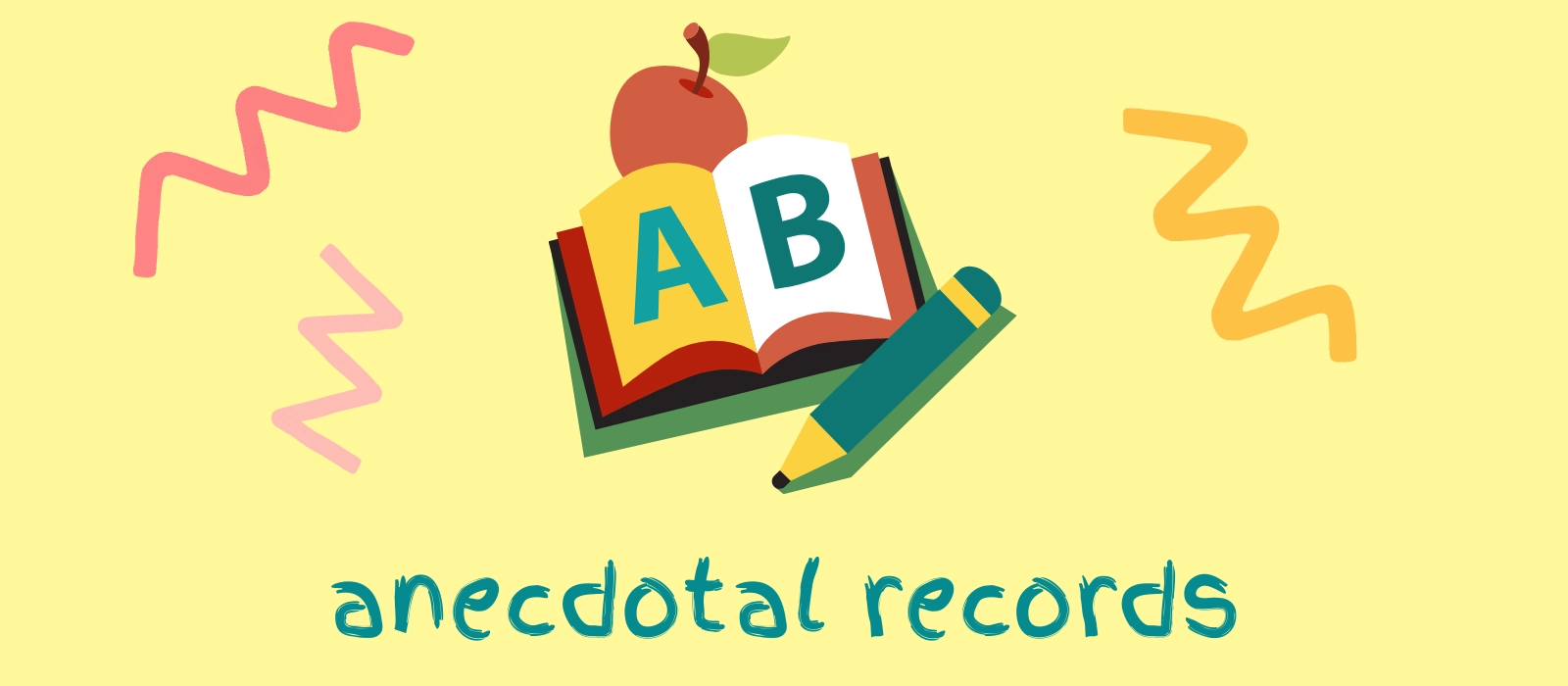Are your classroom observations scattered, inconsistent, or simply forgotten by the end of the day? Have you struggled to recall exactly how a child behaved during a group activity, or what made them upset during lunch? Do you wish there were a more structured way to document and use your insights to support children’s development?
Anecdotal records are a powerful, yet simple observation method used by early childhood educators to capture authentic moments of children’s behavior. They offer valuable insights into developmental progress, inform instructional planning, and serve as effective communication tools between teachers and parents. Implementing them correctly can elevate the quality of your teaching and strengthen your educational program.
If you’ve ever felt overwhelmed by formal assessments or unsure how to capture meaningful child behavior, this guide will help you unlock the potential of anecdotal records in your preschool classroom.
What is an Anecdotal Record?
An anecdotal record is a brief, narrative account of a specific incident observed in a child’s daily experience. It captures exactly what a child said or did, without interpretation or evaluation. Typically written in the past tense and third person, this record is based on direct observation and should be objective, factual, and detailed enough to provide context.
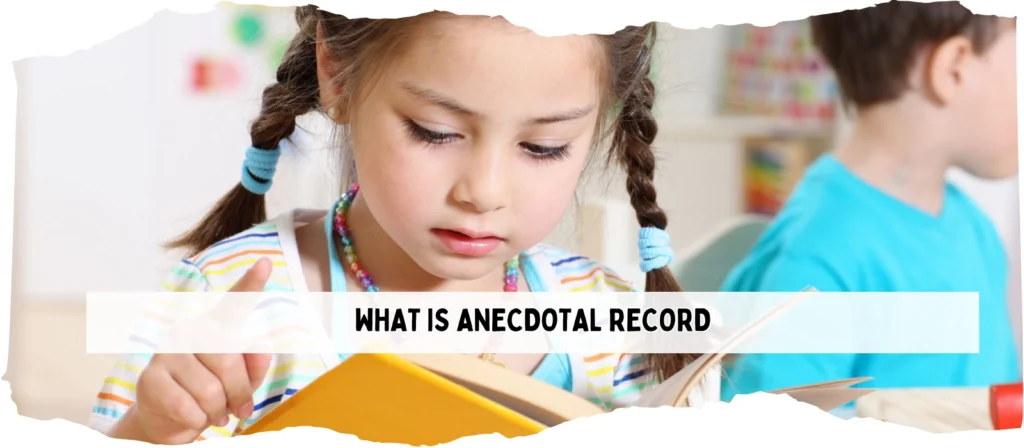
The purpose of anecdotal records is to create a snapshot of a child’s behavior, skills, interactions, and emotional responses. These records become invaluable when educators assess developmental milestones, plan future activities, or communicate with families. Unlike standardized assessments, anecdotal records allow educators to notice the subtle, often overlooked, aspects of a child’s growth.
A good anecdotal record answers key questions: What happened? When and where did it occur? Who was involved? What was the child’s exact language or action? For example, instead of writing “Emma was kind,” a better anecdotal note might read: “Emma handed a toy to Lucas and said, ‘You can play with me,’ while smiling.” This specificity provides clarity and avoids subjective judgment.
These records are typically short—usually no more than a paragraph—but over time, they accumulate into a rich profile of the child’s developmental journey. They can be recorded digitally, in a teacher’s notebook, or via a classroom management app. The key is consistency and accuracy.
Anecdotal records are especially useful in early childhood education because they offer real-time insights during unstructured or play-based learning. They empower teachers to see patterns in behavior, identify learning needs, and celebrate milestones.
Example of an Anecdotal Record
To better understand the format and depth of an effective anecdotal record, here are three sample entries from real-world preschool environments. Each example demonstrates a unique area of child development: social-emotional, language, and cognitive skills.
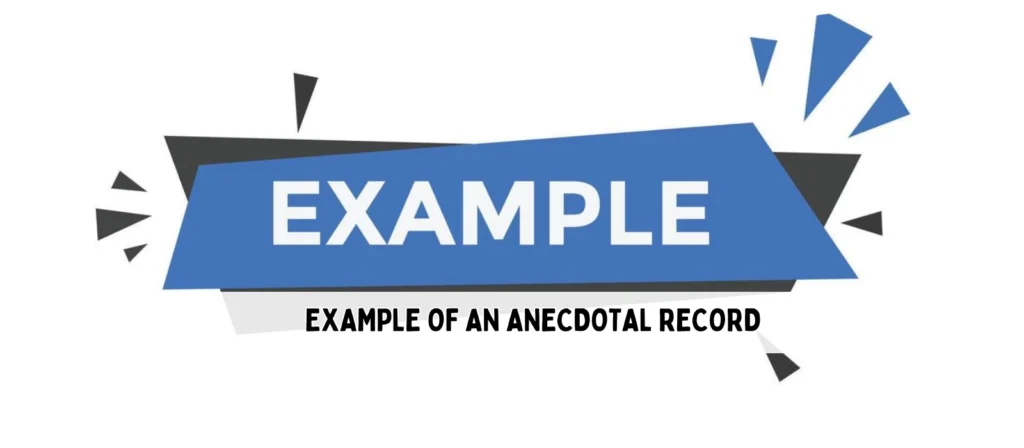
Social-Emotional Development Example
Date: March 5, 2025
Time: 10:15 AM
Location: Classroom Block Area
Observer: Ms. Liao
Observation: Marcus was stacking blocks when Olivia approached. Olivia said, “Can I play too?” Marcus nodded and handed her two blocks. They began building together and took turns adding pieces. Marcus said, “Let’s make it taller.” Olivia smiled and agreed.
Interpretation: Marcus demonstrated cooperative play and turn-taking. His interaction with Olivia reflects growing social skills and emotional regulation.
Language Development Example
Date: March 10, 2025
Time: 9:45 AM
Location: Storytime Circle
Observer: Mr. Chan
Observation: During read-aloud, Bella pointed to a picture and said, “That’s a fox! Foxes live in the forest.” When the teacher asked, “What do foxes eat?” she responded, “Chickens and berries.”
Interpretation: Bella is using descriptive language and applying prior knowledge to engage with text, a key indicator of language comprehension.
Cognitive Development Example
Date: March 14, 2025
Time: 11:30 AM
Location: Puzzle Table
Observer: Ms. Kumar
Observation: Theo worked on a 12-piece animal puzzle. He rotated pieces, tried different combinations, and said, “Nope, doesn’t fit,” before finally matching the shapes. When he completed it, he clapped and said, “I did it!”
Interpretation: Theo demonstrated problem-solving, spatial reasoning, and persistence—important cognitive development skills.
Each of these anecdotal records follows a clear structure: factual observation, context, direct quotes or behaviors, and optional educator interpretation. This approach makes them a useful tool for tracking and supporting individual learning progress.
Anecdotal Record Template
Creating a structured and easy-to-use anecdotal record template is essential for consistent documentation. Below is a sample template that preschool educators can adapt to their own classrooms. You may print it out, duplicate it digitally, or embed it in classroom management software.
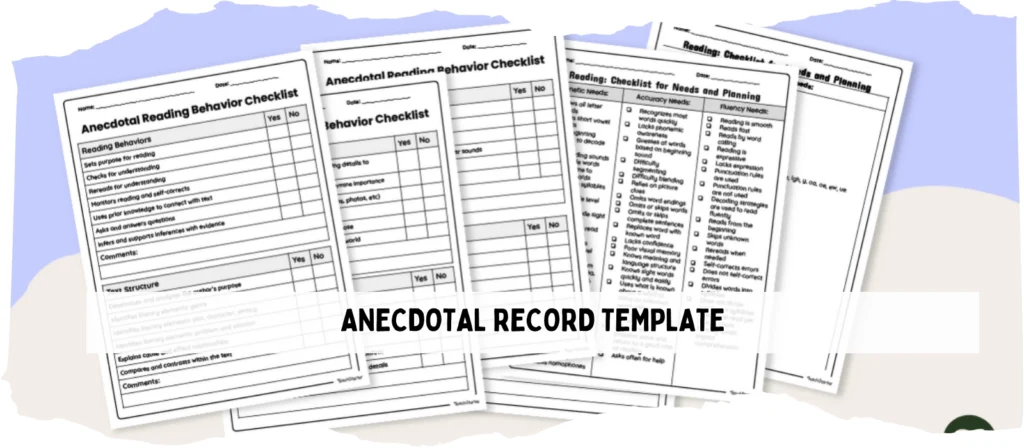
Sample Anecdotal Record Template:
Date: _________________________
Time: _________________________
Location: ______________________
Observer: ______________________
Observation:
(Describe what the child said/did—objective, factual, concise)
__________________________________________________________
__________________________________________________________
Interpretation:
(What does this behavior indicate about the child’s development?)
__________________________________________________________
__________________________________________________________
Next Steps:
(What might the teacher do next based on this observation?)
__________________________________________________________
__________________________________________________________This format keeps the focus on objective documentation while allowing space for analysis and instructional planning. Teachers can use this form during various activities: free play, group discussions, outdoor exploration, or art projects.
For schools using digital tools like HiMama, Brightwheel, or Tadpoles, anecdotal records can be integrated into real-time apps, allowing quicker documentation, photo uploads, and parent sharing.
It’s helpful to store all anecdotal records in a child’s individual portfolio, organized either by developmental domain (social, cognitive, language, motor) or chronologically by month.
Anecdotal Records in Early Childhood Education
Why Are Anecdotal Records Essential for Preschool Teachers?
Preschool teachers face the daily challenge of understanding each child’s unique development. Anecdotal records provide a reliable way to track progress over time without disrupting the natural flow of activities. They enable teachers to collect rich, qualitative data during spontaneous moments—those that truly reflect a child’s personality, strengths, and needs.
These records serve as anchors for informed decision-making. When teachers document what they observe clearly and consistently, they can make better curriculum choices, tailor group dynamics, and offer individualized support. Anecdotal records also prepare teachers to respond confidently in meetings with parents, therapists, or educational specialists.
Moreover, these records help identify learning gaps or behavioral concerns early. A consistent pattern of entries might highlight a speech delay, social struggle, or motor coordination issue, prompting timely intervention. In this way, anecdotal records contribute significantly to child safety and long-term success.
How Anecdotal Records Support Child Development Assessments
Early childhood education relies heavily on formative assessment. Anecdotal records complement tools like DRDP, GOLD, or Montessori progress charts by providing the context behind developmental ratings. Instead of relying solely on a checklist, educators can say, “Here’s what I saw that supports this assessment.”
For example, a child might be rated as ‘developing’ in emotional self-regulation. A teacher can point to a record where the child chose to walk away from conflict instead of reacting aggressively, demonstrating that skill. This specificity makes assessments more credible and actionable.
These records also help track domain-specific growth—language, cognitive, motor, and socio-emotional. They provide evidence for transitions between programs, such as moving from toddler care to preschool, or preschool to kindergarten. When shared in reports or portfolios, they foster continuity between classrooms and caregivers.
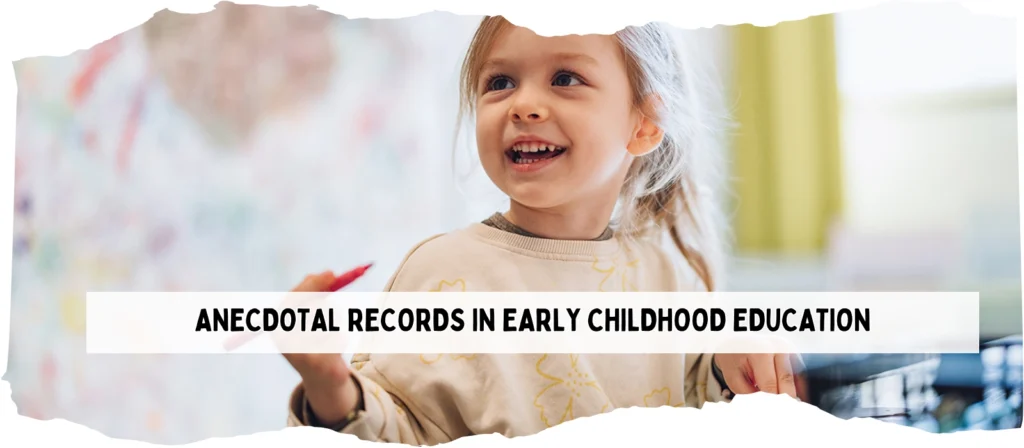
Incorporating Anecdotal Records into Daily Classroom Activities
Anecdotal record-keeping doesn’t have to feel like an extra task. Effective teachers integrate observation into daily routines. While circulating during centers or supervising outdoor play, educators can jot quick notes on sticky pads, mobile apps, or index cards. These are later expanded into formal records.
Teachers can also assign observational roles during co-teaching or team planning. One teacher may lead a lesson while the other focuses on documenting key interactions. Over time, observation becomes part of the classroom culture, not a burden.
The most insightful observations often occur during transitions, free play, or unstructured group time. Educators should keep tools handy and avoid over-editing—authenticity is more valuable than polish.
Using Anecdotal Records for Parent Communication and Reporting
Parents appreciate meaningful, specific updates about their children. Anecdotal records offer an excellent foundation for this communication. Sharing a moment like “Lily comforted a peer by saying, ‘It’s okay, you can have my bear’” paints a richer picture than generic praise.
In parent-teacher conferences, these records reinforce professional credibility. They show that observations are not assumptions but rooted in real events. Teachers can explain developmental stages, justify intervention plans, or celebrate achievements with clear documentation.
Schools can also use anecdotal records to enhance newsletters, portfolios, and end-of-year reports. With proper permission, these records—even anonymized—can illustrate classroom values and teaching strategies for incoming families.
How to Write Anecdotal Records
Writing anecdotal records effectively is an essential professional skill for preschool educators. The goal is to document behaviors in a way that is clear, concise, objective, and actionable. Below are the key steps and best practices for writing high-quality anecdotal records:
1. Observe First, Write Later
It’s important to remain mentally present during the interaction rather than rushing to record every detail immediately. Use shorthand notes or audio memos to quickly capture highlights, then complete the full anecdotal record shortly afterward. This ensures observations are authentic, while still retaining enough detail for an accurate record. Training yourself to observe patiently first helps you develop keener insights and reduces the risk of bias.
2. Use Objective, Descriptive Language
Descriptive clarity is critical. Avoid using emotional or judgmental language. Rather than saying “Leo was mean,” describe exactly what happened: “Leo took the truck from Max without asking, then looked away when Max said ‘Hey!’” This not only avoids teacher bias, but also allows the reader to form their own conclusions from the observable facts.
3. Include Contextual Details
Anecdotes without setting and timing can be misleading. Was the child playing alone? Was this before naptime? Context helps interpret behavior. For instance, an outburst just before lunch could be hunger-related, not necessarily defiance. Always include the who, what, when, where, and how to make the entry meaningful.
4. Capture Direct Quotes When Possible
Children’s language is full of developmental cues. A child saying, “I don’t like that—it’s too loud!” during a music activity offers insight into sensory sensitivity and emotional vocabulary. Quotes preserve authenticity and provide linguistic evidence for growth. When quoting, use quotation marks and note the exact words.
5. Keep It Concise But Meaningful
Quality trumps quantity. A single paragraph (3–5 sentences) that effectively describes an event can be more powerful than a page-long reflection. Avoid overly detailed transcripts unless necessary. Focus on the core behavior, its context, and any outcomes to ensure the observation remains usable.
6. Avoid Bias or Interpretation in the Observation Section
The observational section must remain strictly factual. Leave out your thoughts or assumptions. Instead of “Lila was sad,” say, “Lila sat on the rug with her head down and didn’t respond when called.” Reserve any interpretation for a separate area in your template labeled ‘Reflection’ or ‘Assessment.’
7. Use a Consistent Format Across the Team
Establishing a shared format promotes clarity across staff and supports record-keeping systems. Whether digital or paper-based, consistent templates allow team members to compare, track, and analyze child development more systematically. Include designated fields like date, time, setting, and developmental domain.
8. Reflect on the Implications
A strong record goes beyond what happened—it considers what it means. After your observation, ask: What does this tell me about the child? What skills are emerging or need support? How can I adjust my teaching strategy? These reflections inform planning and professional growth.
9. Maintain Professionalism and Privacy
Respect confidentiality at all times. Use child initials or ID numbers when discussing records in meetings. Never share anecdotes publicly or with unauthorized parties. Store records securely, whether digitally or physically, and follow school or district data policies.
10. Practice Regularly
Writing high-quality anecdotal records is a skill that improves with frequency. Encourage peer reviews within your team. Share samples (with names redacted) during planning meetings and discuss how observations inform instruction. Over time, writing anecdotal records becomes second nature and enhances your teaching impact.
Advantages and Disadvantages of Anecdotal Records
Anecdotal records are a widely used method in early childhood education, offering valuable insight into children’s development. However, like any tool, they come with strengths and limitations. Understanding both helps educators use them strategically.
Advantages of Anecdotal Records
- Authenticity: Captures real, spontaneous behavior in natural settings without prompting or testing.
- Simplicity: Easy to implement without specialized training or equipment.
- Flexibility: Can be written anytime, anywhere, and cover any developmental domain.
- Rich Qualitative Data: Provides detailed context and emotions behind actions, unlike checklists or ratings.
- Supports Assessment: Complements formal tools by offering concrete examples for evaluation.
- Personalized Planning: Helps tailor activities and support to individual children’s needs.
- Documentation for Communication: Useful in parent meetings and professional collaborations.
Disadvantages of Anecdotal Records
- Time-Consuming: Requires consistent writing, review, and organization.
- Subjectivity Risk: Despite best efforts, personal bias may influence what’s recorded.
- Inconsistency: Without team standards, entries can vary greatly in depth and quality.
- No Quantitative Data: Lacks the numeric tracking ability of other methods.
- Incomplete View: Single events may not represent broader patterns.
- Storage Challenges: Especially in paper format, managing volume can be difficult.
- Requires Regular Review: Otherwise, valuable insights may be missed or unused.
Summary Comparison Table
| Feature | Advantages | Disadvantages |
|---|---|---|
| Data Quality | Real, rich, contextual data | Not standardized or quantifiable |
| Ease of Use | Simple to learn and apply | Time-intensive to maintain consistently |
| Flexibility | Adaptable across all domains and settings | Variability in observation quality |
| Communication Support | Enhances parent and team collaboration | Requires thoughtful selection and interpretation |
| Assessment Compatibility | Aligns with authentic assessment models | Doesn’t meet all formal reporting needs |
By recognizing both the advantages and drawbacks of anecdotal records, educators can decide when and how to use them most effectively, often in combination with other observation tools.
Alternative Observation Methods in Early Childhood Settings
While anecdotal records are a valuable tool, they’re just one of several observation strategies used in early childhood classrooms. Understanding alternative methods can help educators build a comprehensive approach to child assessment. Each method has its strengths and is suited to different observation goals.
Running Records vs. Anecdotal Records
Running records provide a continuous, moment-to-moment account of a child’s behavior over a set period. Unlike anecdotal records, which focus on specific incidents, running records attempt to capture everything a child does or says in real-time.
This method is ideal for studying attention spans, social interactions, or transitions during specific time blocks. However, it requires intense focus and rapid writing, making it more labor-intensive. Running records are particularly useful for detailed behavioral studies or identifying patterns.
Using Checklists for Developmental Milestones
Checklists are standardized tools that list developmental indicators across various domains—motor skills, language, cognition, and social-emotional development. Teachers can quickly mark whether a child consistently demonstrates a behavior or skill.
The advantage of checklists is efficiency and uniformity. They’re excellent for large groups or when schools require formal reporting. However, they don’t capture the how or why behind behaviors, and they may miss contextual richness that anecdotal records provide.
Time Sampling and Event Sampling Explained
Time sampling involves observing a child at predetermined intervals (e.g., every 5 minutes) and recording what is happening at that moment. This technique helps gather data on frequency and duration of behaviors—ideal for studying attention or activity levels.
Event sampling, on the other hand, focuses on specific behaviors. Whenever that behavior occurs (e.g., aggression or helping behavior), the observer records details. This method is great for monitoring rare or important actions but requires clear behavioral definitions and consistency.
Choosing the Right Method for Your Classroom Needs
No single method works best in every scenario. Teachers often combine techniques. For example, a teacher might use checklists for curriculum benchmarks, anecdotal records for social-emotional tracking, and event sampling to document interventions.
Choosing a method depends on the goal of observation, class size, available time, and reporting requirements. Blending methods ensures both depth and breadth in documentation. Professional development and team collaboration can help refine observation strategies.
Understanding these options allows educators to respond more effectively to diverse child needs, institutional standards, and family expectations.
Conclusion
Anecdotal records are an indispensable part of early childhood education, helping teachers understand the whole child beyond scores and checkboxes. They offer authentic, narrative-based evidence of children’s growth, creativity, and needs—making classroom practices more intentional and personalized. Whether used alone or alongside other observation tools, anecdotal records provide clarity in teaching and communication.
At XIHA Furniture, we understand that meaningful learning starts with understanding the learner. Our thoughtfully designed preschool furniture supports educators in creating organized, observation-friendly environments—spaces that allow every anecdotal moment to be captured, nurtured, and celebrated.
To transform your classroom into a place where every child’s story is seen and supported, visit us at XIHA Furniture — your trusted B2B partner for quality and affordable kindergarten solutions.

